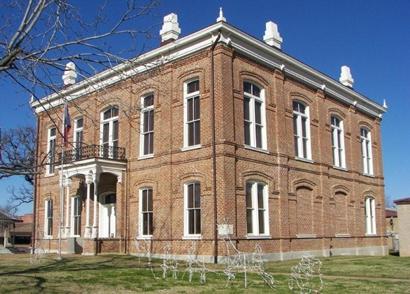|
Leon
County Courthouse
Photo courtesy Terry
Jeanson, December, 2008 |
Date - 1886
Architect - William Johnson
Style - Renaissance Revival
Material - Brick
The 1886 Courthouse stands next to the Leon County Jail on the square.
A misunderstanding between county commissioners and the contractor
resulted in the cost being almost double of the estimate.
The 1858 Courthouse burned in 1886 and was replaced.
Only the 1886 courthouse is still standing. The front side of the
Courthouse faces Saint Mary's (Texas 7.)
Centerville
Hotels > Book Hotel Here |
"Southwest
corner of the courthouse. The bushes, a pine tree and other foliage
were removed during restoration. The building at the far right in
this picture is the old 1913
county jail."
- Terry
Jeanson, December, 2008 photo |
1886 LEON COUNTY COURTHOUSE
PHOTOGRAPHER’S NOTE
A framed invitation in one of the offices of this courthouse reads,
“In 1887, Leon County
had a new courthouse! In 2007, 120 years later, Leon
County dedicates their restored courthouse!” The celebration on
July 1, 2007 brought to a close a seven year effort to restore this
historic building.
During my first visit to Centerville
in August of 2005, I discovered the courthouse closed to visitors
and in poor condition. A woman at the Chamber of Commerce informed
me that the building was condemned. The outer brick walls were being
supported by steel beams to keep them from bulging outwards any further
and the front entrance portico was badly deteriorated. The building
is now in pristine condition and is once again open to serve Leon
County citizens.
Built during the “golden age” of courthouse construction, the box-shaped
building does not have the grand features of other Texas county courthouses
of that time and reflects an earlier era of Texas county courthouse
design. This in no way deters from the building’s appeal, but only
enhances its uniqueness among the collection of the state’s historic
county courthouses. The style, referred to as Renaissance Revival
or Greek Revival, is characterized by repetitive features, especially
around the windows. Although architect William Johnson’s name is on
the building’s cornerstone, other sources, including the Texas Historical
Commission, credit Houston architect George Edwin Dickey for the building’s
design. It was built on the same plot of land as the previous courthouse
which burned down in November of 1885. Some of the bricks from the
former courthouse, which were locally made, were used in the current
courthouse.
The interior restoration of the courthouse is probably more impressive
than the exterior. I was fortunate enough to meet Leon County Judge
Byron Ryder during my visit and he gave me a short tour and informed
me about some of the building’s features. The ceilings, which had
never been lowered, are 16’ high on the first floor and 20’ high in
the courtroom. (The judge also said that the attic is very large,
but he has never personally been in it.) Just about every inch of
wood on the interior is original and has been restored, including
the staircase, the floors, the wainscoting and the ceiling. The wooden
wainscoting has been restored to its original dual color scheme and
the building’s many fireplaces have also been restored, although no
longer functional. According to the Centerville News (7/4/2007,) the
courthouse was restored to its 1906 condition, which included jury
boxes on each side of the courtroom." Judge Ryder explained that this
was done so that the jury could sit on the shady side of the courthouse,
depending on the time of day. Some of the modern additions to the
courtroom include removable cushions for the wooden benches in the
gallery and a thick sheet of bulletproof glass behind the judge’s
bench which sits over the front entrance. Additional and updated restrooms,
along with the building’s first elevator, have also been installed.
There are also two steel vaults displayed in the courthouse which
survived the fire that destroyed the 1858 building. Judge Ryder has
one of them in his office which he uses as his personal filing cabinet.
A hand-painted sign in the glass transom over the judge’s office door
(which says “Tax Collector”) has also been restored along with other
transoms in the front offices.
Judge Ryder said that the main reason the courthouse never received
a modern overhaul was simply that the county could never afford it,
which was actually beneficial during their restoration efforts. Before
leaving, I asked him if he thought that the restoration of the courthouse
was worth all the time and expense. He did not hesitate to say, “Yes!”
It was pretty obvious from what I witnessed during my visit that everyone
was pretty happy with the results and very proud of their historic
courthouse. - Terry
Jeanson, December, 2008
Book Hotel Here > Centerville
Hotels |
 |
Leon County
courthouse after restoration
Photo courtesy Terry
Jeanson, December, 2008 |
Leon
County courthouse as it appeared in 1939
Photo courtesy TXDoT |
Black-Eyed Pea
Festival, which began in 1937
and ran three consecutive years until WWII.
Courthouse & jail in the background.
1930s vintage photo courtesy Jean Broussard |
Leon County
Courthousethe front entrance portico before restoration (left, August,
2005) and after restoration (right, December, 2008.)
- Terry
Jeanson |
Courthouse main
staircase.
Photo courtesy Terry
Jeanson, December, 2008 |
"The judge's
dais, with a thick sheet of bulletproof glass in the window behind
the judge's chair. The district courtroom on the second floor has
a twenty foot high ceiling."
-
Terry
Jeanson, December, 2008 photo |
The judge's bench
before restoration
TE Photo, 2001 |
Restored jury
box on the east side of the district courtroom.
Photo courtesy Terry
Jeanson, December, 2008 |
The jury box
before restoration.
TE Photo, 2001 |
"One of
the steel vaults, saved from the previous courthouse, still contains
books and documents from the early days of Leon County."
Terry
Jeanson, December, 2008 |
|
|
